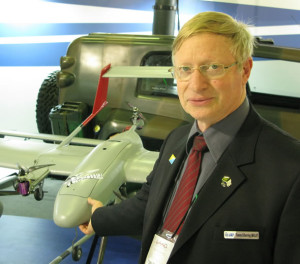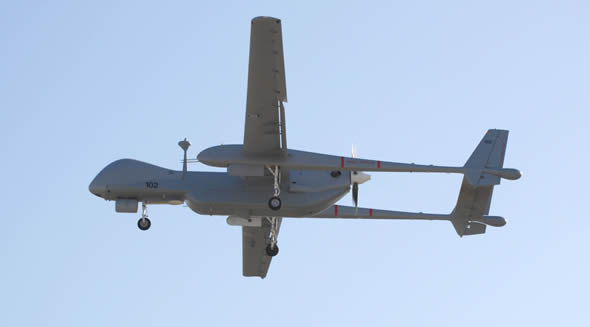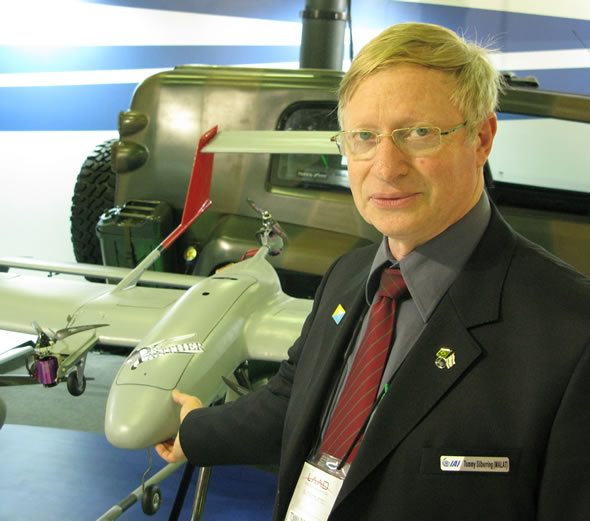
Unmanned Aerial Systems (UAS) have established a leading position in modern air power, already performing far more operational hours, compared to any other military aircraft. Typically, UAS fly 2,000 operational hours a year on average, compared to manned fighter jets that perform 200-400 hours / year at a typical military environment.
The world’s pioneer in tactical UAS and one of the world’s leaders in this field is Israel Aerospace Industries (IAI), UAS division MALAT, part of IAI’s Military Aircraft Group. IAI’s UAS have officially passed 900,000 operational hours, and are rapidly nearing the million hour milestone.

One of the drivers of the immense growth in the demand for UAS is their high utilization, compared to manned aircraft. “UAS incur low overhead cost per flight hour and therefore, they are assigned more and more missions.” says Tommy Silberring, (IAF Col. res) General Manager of IAI Malat Division. “With this extensive operational tempo the user’s appetite for UAS services grow, fulfilling the hunger for more systems. This trend brings the demand for longer endurance, persistence and multi mission capability, far beyond the level offered by manned aircraft or to what UAS were providing in the past.”
Defense Update: This growing demand also brings competition to this playground
Silberring: The competition is very intensive at the smaller UAS, where many competitors are offering small and mini UAVs that are relatively simple to build. However, successful systems can only be those developed with entire system approach with the know how and engineering that meet the demands of the users in the field and smoothly integrate within the military logistics and operations and provides the high safety standards and survivability to endure a hostile environment.
As you go to the upper tiers, there are less and less competitors, as these systems are much more complex and need multidisciplinary approaches that only mature aerospace manufacturer has. As a system house operating in many diversified fields we have great advantages here, offering platforms, sensors and payloads, datalinks and satellite communications, radar, COMINT and SIGINT, intelligence processing and dissemination, command and control. We can combine in house elements into a robust integrated solution, or integrate other equipment manufacturers (OEM) if it is required by the customer. Such capabilities are rare in this field, all under ‘one roof’, integrated with a ‘system of systems’ approach.
Defense Update: Can you give an example of such integration?
Silberring: “The Maritime Heron Plus recently introduced by IAI Malat offers new capabilities to enable the aircraft to integrate into a civilian air traffic controlled airspace. We integrated a new communications relay into the platform, enabling the aircraft to receive, process and respond to ATC instructions, flight plan and keep zone just as a manned aircraft. This comes in addition to the standard Maritime Heron mission package, which also includes an ELTA developed, multi-mode maritime search radar, EO payload, COMINT and SIGINT sensors, along with satellite communications link, enabling the system to operate at distances of 1,000 km on 30 hour missions.

Defense Update: Can you describe this ATC integration in more details?
Silberring: “To support such capability IAI added several elements to the platform, including an Interrogator Friend/Foe (IFF) and Communications Relay (Com Relay) integrated with the satellite communications channel, enabling the UAV controller to communicate with local air traffic control (ATC) as he/she was inside the aircraft. II has already received approvals from the civil aviation authorities in France, Belgium, Spain, USA, Australia and others, to fly some of its UAVs in civil airspace. Beyond the ATC integration, the Com Relay has also military advantages, when integrated with satellite communications, it extends Line Of Site (LOS) communications (typically limited to 100 – 200 km), to provide an airborne radio and control over a large area, overcoming mountainous terrain or other interference, supporting ground units with efficient, and reliable communications within its area of operation. Airborne relay can also support maritime operations, improving communications with ships at sea and overcoming weather or other atmospheric interference. In addition, all the airborne information gathered by the sensors on board is streamed to a central control and intelligence center to analyze and distribute the information to all users.
These new capabilities are meeting evolving requirements coming from the field, enabled within the Heron ‘System of Systems’ approach. IAI was the first company in the world that introduced this concept, and we lead in this field today. The systems involved are based on open architecture that can be flexibly modeled to meet different requirements, integrate new capabilities in timely manner and meet urgent customer requirements within a short time. To meet such demands MALAT is responsible for the entire system, sourcing specific services or elements form other IAI divisions or outside the company. While conventional development cycles take years, our teams have demonstrated fulfilling urgent requirements within much shorter periods.
Defense Update: You have already demonstrated long endurance with your larger platforms, what about tactical and mini UAS?
Silberring: Long endurance missions will typically require large and heavy platforms, while persistent platforms that have to remain operational over long time in hostile area, should be designed to be more redundant. Fuel cells could provide a solution for these missions. Part of the solution can also be provided by solar panels, providing on-board renewable energy generation to sustain long endurance operations.
We are examining various types of fuel cells, and their integration in our platforms. Overall, fuel cell technology has yet to mature to an operational level. Most fuel cells are based on hydrogen as a propellant. Some use compressed hydrogen which poses potential hazards if the container is damaged by enemy fire or in an accident, increasing collateral risk to human lives and property. Other methods employ on board hydrogen generation, which produces only the amount of hydrogen needed to produce the energy for the platform’s consumption or battery recharge. These systems can also throttle back and force, further extending mission endurance with given resources. Flying different platforms utilizing fuel cells we have already demonstrated up to three times longer endurance, of up to 10 hours. We expect this energy source to power future versions of the 65 kg Panther and 11 kg Birdeye 650, However, at present, despite the great promise we feel this technology is not matured yet for operational use. The issues are not technological but relate to production and maintenance of such systems at the field level. I expect this capability to mature within the next 18 months, enabling these platform to perform extended day and night missions, generating extremely low acoustic signature for covert operations.
Defense Update: What about mission persistence? Are you aiming specific platforms for that?
Silberring: The two requirements are not identical, endurance and persistence are met by different platforms, responding to specific military requirements. Based on cost/performance tradeoff, expensive, multi-mission platforms are generally geared toward the long endurance missions which also associate operations over great distances, while smaller systems with persistent on-station capability will be aimed at wide area, airborne persistent surveillance (WAAPS).
IAI is examining different new concepts for long endurance platforms. Mission endurance is a central requirement for WAAPS but such a platform also must be able to survive over a hostile area. Nevertheless, if one platform is lost, such loss should not put the entire mission at risk. Therefore, the tradeoff for such platforms is different, aiming at more affordable systems offering redundancy; that can be provided by a constellation of platforms rather then single units. Constellations of multiple vehicles offer the endurance, redundancy, survivability, persistence and resilience required to dominate wide, complex areas supporting multiple users with real-time information.
To come up with solutions, you have to think ‘out of the box’. An example is the ETOP, developed by IAI, employing a tethered hovering platform that offers virtually unlimited endurance as it is fed by ground bound generator. The ETOP is designed to replace tactical aerostat with an easily and rapidly deployable system, more maneuverable and responsive and much more survivable than an aerostat. Other hovering sensors we are currently developing are the Mini Panther and Ghost, offering small infantry and special operations units an organic mini UAV that supports the lowest tactical level.
Defense Update: Back to the maritime UAVs, you were developing the Naval Rotary UAV (NRUAV) with HAL of India. What is the status of this program?
Silberring: We are working with our partner HAL to define the scope of the NRUAV program. Such projects are complex and require long time to mature. The development, funded by the Indian Ministry of defense will require 36-48 month to proceed, depending on the mission requirement and level of complexity. The first level we are aiming at includes opening of the flight envelope, and integration of the basic sensor package including maritime search radar and an electro-optical payload. NRUAV will offer weather independent helicopter operation for ships at sea, enabling the crew to launch missions even in high wind or rough sea. NRUAV will also offer twice the mission endurance of similar manned helicopters (up to 5.5 hours with the Cheetak). When completed, NRUAV will be offered as a flyaway kit for installation in specific helicopters, it will add few hundred pounds to the platform’s weight, and offer significant independence for the user, replacing the crew with fuel, mission payloads or both. We intend to introduce the NRUAV kit during major overhauls, typically involving the replacement of engines and transmissions and other dynamic elements, enabling operators to modernize and enhance the capabilities of their helicopters.
Defense Update: Another application being proposed for the Heron TP is ballistic missile warning. Do you foresee such capability being met by existing platform or dedicated Heron TPs?
Silberring: The main advantage of the Heron TP is its cruising altitude. From such heights the horizon is hundreds of kilometer away, far extending its sensing capability, Yet the systems on board should be mission oriented and, therefore, I expect, if a customer decides to integrate a missile warning system, to be a dedicated one rather than an ‘add on’ system. This approach depends on the multi-layered defense system it comes to serve.





















